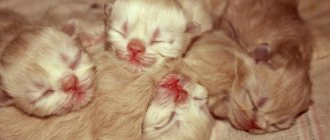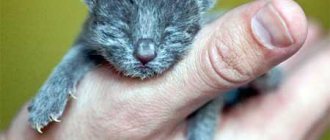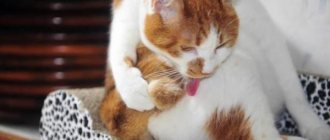Cats are animals with highly developed natural instincts. Therefore, as a rule, intervention in the lambing process is not required. However, every pet is dear to its owner. Therefore, the cat owner must have an understanding of cat pregnancy and childbirth in order to help her or provide assistance in case of complications. If there are no pathologies, then the cat will give birth to offspring on its own. And the owner’s role will be reduced to observation, organizing a place for lambing and good feeding.
Messages [4]
1 Topic by Yuli4ka 2010-04-06 18:11:36
Topic: stuck kitten
When my cat gave birth for the first time, her third kitten walked with its paws and got stuck. in this case, on the advice from one magazine about pets, I lubricated the place where the kittens come out with warm oil and slowly pulled. It was not possible to save the kitten; he suffocated, but mommy feels great.
2 Reply from Babydoll 2010-04-12 21:25:50
Re: stuck kitten
In such situations, it is usually advised to grab the kitten by the paws and gently pull. But be very careful not to damage the spine. And this is the first time I’ve heard about lubrication of a place!
3 Reply from Irinka 2010-08-02 19:17:01
Re: stuck kitten
If the kitten walks with its paws and gets stuck in the birth canal, then they need to be carefully pushed into the mother’s body. During the break in contractions, the kitten can change position in the mother’s body and be born normally during the next contractions. This happened with our cat, and on the advice of the veterinarian, everything went with a bang, 3 healthy kittens.
4 Reply from DRoog 2010-08-22 18:08:57
Re: stuck kitten
If during childbirth the paws first appear and get stuck in the birth canal, then they need to be pushed back into the mother’s body. After a minute, the kitten can change position and be born normally during the next contractions.
What to do
- Medicine
Some forms of uterine inertia are caused by a lack of oxytocin or calcium, or both. To stimulate stronger contractions, your veterinarian may administer oxytocin (which is produced by the pituitary gland) and calcium gluconate. There is a risk with these injections that the uterus may rupture.
- C-section
If labor difficulties cannot be resolved with medication or obstetric treatment, your veterinarian will determine whether a cesarean section is necessary. The veterinarian will decide whether this common procedure, which is used for all sorts of birth problems, is the best choice for the mother. The veterinarian will take into account the following:
- Duration of contractions
- Cat's condition
- X-ray and test results
- Size of kittens relative to the uterus
- Dry vaginal canal
- Lack of response to oxytocin
In most cases, a caesarean section is not a problem, especially if the cat is young and healthy. The veterinarian performs the operation under general anesthesia. Serious problems can arise if labor is excessive and prolonged and toxicity occurs, such as kittens being stillborn and starting to decompose, or if the uterus ruptures.
Cat giving birth
The article discusses the main decisions that could be made in a similar situation at home, and also provides answers to frequently asked questions. Write your life stories and advice in the comments.
What is birth in cats called?
The process of giving birth to offspring in cats is called lambing. The same name applies to other genera of mammals.
First births in cats, how many kittens are there?
The number of kittens in a pregnant cat can be determined through an ultrasound examination. If a cat becomes pregnant for the first time, the offspring can number from one to three kittens, depending on the breed, the cat’s body and health status. Subsequent pregnancy will increase the number of kittens.
If a kitten gets stuck during labor and delivery, what to do?
Childbirth in a cat is not always quiet and successful; there may be cases when the kitten gets stuck in the birth canal and then it is necessary to urgently intervene in the birth process. There are two ways to help a cat: a caesarean section or removing a stuck kitten yourself.
To do the latter, you need to gently massage your stomach, as soon as new contractions begin, you need to catch the rhythm and massage in time with the contractions. In this case, you should not pull the kitten by the head and perpendicular to the cat; you can damage the baby’s neck and fragile spine.
You need to reach the kitten by pulling the skin of the neck or body from side to side without sudden movements.
If a kitten walks with its tail during birth, is it normal or not?
When giving birth to kittens, in 20% of cases, birth with legs forward is possible. In general, this is a normal phenomenon, but may not always be successful. In order for the kitten to be born fully, you can hold it by the belly and very carefully pull it towards you. After removing the kitten from the birth canal, it is necessary to allow the cat to gnaw the umbilical cord.
Helping a cat give birth at home and how to give birth to a cat, what to do
Childbirth in a cat lasts up to 36 hours. The main part comes when the cat begins to flicker, arrange a floor for herself for a comfortable birth, carefully lick herself and meow.
At first, you shouldn’t interfere; you can only stroke the sides and closer to the tail, speaking in a gentle tone to support the pregnant cat. After which the first contractions begin, the cat’s muscles contract and move in waves throughout the body.
When the kitten turns around and begins to walk along the birth canal, a small bump is visible in the abdomen area, which is prohibited from being touched. Childbirth in a cat should take place in an intimate setting; you cannot call everyone together to watch the process, much less invite guests.
The pet must feel protected, otherwise the birth may be interrupted or the kittens will be born dead.
What to feed a cat after giving birth
After giving birth, the cat eats the placenta, and then you need to feed it after 4-5 hours, but be sure to provide warm milk or water. Since the body is quite weak, it needs easily digestible and nutritious food so that the cat can regain strength and provide full-fledged milk for its babies.
For the first 10 days, dairy products, vegetables and boiled chicken should be given, but in small quantities. Dry food should not be given, as it does not contain water and can lead to stomach blockage.
After the cat's 12-day recovery period, basic food containing magnesium and calcium can be introduced to strengthen the cat's bones.
If a kitten is born dead, what to do and why this happens
When giving birth to a cat, there may be cases of the birth of still kittens, or suspicion of this. In order to determine whether a kitten is dead or not, you need to hold the kitten upside down to stimulate breathing, and if it does not come to life and does not move, then the kitten is really dead.
This happens when something interferes with the birth or suddenly frightens the cat, also due to strong contractions and external factors. A cold place to give birth, a draft, or a blockage in the kitten's airways can lead to its death.
If a cat has not given birth to all kittens and does not give birth, what to do?
During the birth process, the birth of kittens may not always be complete. It happens that a cat does not give birth to her last kitten, then you should carefully monitor the cat’s behavior.
If the cat is not at all worried about this, then perhaps the uterus has not contracted and the birth of the last one may occur within 12 hours. If the cat looks anxious, then you should immediately contact a veterinarian to save the kitten and the cat.
How does a cat's water break and how long does it take?
Childbirth in a cat lasts up to 36 hours. Until this moment, about 65 days pass from the day of fertilization, and the moment comes when the waters break. This process can last from one minute to about an hour. After which comes the birth itself, the process can begin either immediately or after a few hours.
Premature birth in a cat: how to help
Premature birth in a cat is very rare and does not just happen. This often depends on the cat's breed and environmental factors. In non-pedigree cats, this phenomenon can occur without complications and death of offspring, unlike purebred cats.
If a purebred cat gives birth prematurely, it may lose its offspring or die itself, so you need to be very careful about this pathology.
In order to help the cat you need to look after it. Premature birth can begin very intensely and end with the kittens dying out, so they give medications to relieve stress. If it is impossible to help your cat at home, then you need to call a veterinarian.
How to find out when a cat will give birth at home and how she prepares for childbirth
On average, a cat's labor lasts 35 hours. For the first 22-24 hours, she will walk, look for a place for a favorable birth, then the water will break, and the cat will begin to meow and lick itself, lying down comfortably on a soft and warm place. A few hours later, the birth of the first kitten will begin.
How long does labor last for cats?
Cat labor generally lasts for 34-36 hours without complications. Childbirth is divided into 3 stages: the first stage – 15-20 hours (first contractions), the second and third stages last up to 8 hours (direct birth from the first to the last kitten with placenta).
Childbirth in cats, interval between kittens
Each cat's body is individual and each cat's birth can take place at a different time interval. The standard time between the births of kittens can be from 5 minutes to several hours. If the interval is more than 5 hours, then you should contact a veterinarian or stimulate contractions yourself.
Preparing for birth at home
Every owner worries about how to help a cat give birth to healthy offspring. To do this, certain measures should be taken.
Arrangement of the nest
- It is unlikely that a mother will give birth on a thin bedding or bare floor. Definitely, she will look for a more comfortable place.
- Take a shallow, wide box and lay a mattress or a soft, unnecessary jacket on its bottom. You can sew a mattress yourself by stuffing it with padding polyester, or you can use a towel or blanket for these purposes.
- Make sure that there are no buttons or threads sticking out of the bedding. In addition, the fabric should not slip so that kittens can crawl on it freely.
- Immediately before giving birth, the kitten needs to be placed in a nest so that she can pre-settle in there.
- Be prepared for the fact that the capricious person may not like your carefully prepared “maternity hospital”, and she will go to huddle in the closet or on your bed.
- To attract the animal, place the “house” in a dark and quiet place.
- Once the mother is settled in, place disposable pet bedding on the bottom.
Important! Sometimes when a cat gives birth for the first time, she needs your presence nearby, so she may run away from the nest and follow you demandingly and whine. Give the animal some time, as she needs your help.
What tools and materials need to be prepared
To ensure your cat gives birth without any problems, prepare:
- cotton threads;
- petrolatum;
- scissors;
- antiseptic;
- cloths or diapers.
In addition to all of the above, you should always have a 24-hour veterinary emergency number at hand. Just in case, have a carrying bag ready.
Remember! If you see complications or are not confident in your abilities, it is better to take the mother to the clinic or call the veterinarian at home at the first signs of labor.
Duration of labor and alarming symptoms
- contractions are clearly continuing, but the kitten has not appeared for more than an hour;
- it is clear that the kitten is stuck (it is walking backwards or is too large, sometimes you can help yourself, as discussed below);
- the temperature in cats during birth rose above 39.5°C or fell below 37°C;
- discharge from the vulva is profuse, bloody, purulent, and smells disgusting;
- the cat is weakened, makes no attempts to expel the fetus, lies prone, breathes weakly;
- the heart rhythm is disturbed (the heart will beat very quickly, but it should “beat” smoothly, without jumps, fading, etc.).
Signs of approaching labor
Signs of impending labor in cats can appear either the day before birth or one to two hours before it. It depends on the characteristics of each cat’s body. In cats giving birth for the first time, symptoms begin earlier because the animal’s body takes more time to adjust.
Signs of imminent labor are as follows:
- The animal loses its appetite, it drinks a lot - this is how the body prepares for lambing ;
- Manifestation of lethargy - the cat spends almost all of its time in the place that it has chosen for birth;
- The active movement of the abdomen is noticeable, since the kittens move energetically before the onset of contractions, taking the most convenient position for passing the birth canal. If there are many kittens or they are large, then such a movement can begin two days before birth;
- The cat actively licks the genital slit, because... vaginal discharge appears. She maintains cleanliness as this is important to prevent infection;
- The removal of a plug that covered the uterus during pregnancy. If the plug comes out, labor will begin within one to two hours;
- Rectal temperature drops to 37 degrees (this prevents bleeding after childbirth and during the process);
- The appearance of colostrum - when you press on the nipples, a white drop appears;
- The cat hunches over, screams and tries to hide - this behavior is possible 4-6 hours before the onset of labor due to the appearance of false contractions. They prepare the appearance of kittens, but do not open the uterus. False contractions help determine the appearance of real contractions.
Obstetrics
- if the bubble is intact and/or the baby goes with its head, you need to wait for the next contraction - the cat will push the kitten out. This is exactly what happens in the vast majority of cases;
- if the bladder is ruptured, you can help - after waiting for the contraction, take the kitten with a piece of gauze and lightly pull it in an arc down towards the stomach. All manipulations are performed using surgical gloves. If it is uncomfortable to operate with gloves, or you feel stiff, you need to treat your hands with alcohol (nails should be filed short);
- if the bladder is ruptured and the kitten is walking butt, you need to get the baby out as soon as possible, as he may suffocate. Pull gently, only during a contraction, in an arc towards the stomach. Under no circumstances should you drag a kitten by grabbing a part of the body or the head.
- We are waiting for the next contraction and the moment when the bubble appears at the vulva;
- With your index finger we penetrate the vulva in the lower part, just a few millimeters, and gently press on the perineum towards the anus, expanding the passage. Dry birth canals can be moistened with sterile petroleum jelly. Perhaps this will be enough;
- when the head comes out and the shoulders or at least one shoulder appear, with your free hand we carefully take the kitten (not by the head) and little by little swing it to the sides and down in an arc with a light, gentle effort, gradually pulling it out.
- light massage of the tummy in a circular motion, starting from the chest towards the vulva, very gently, without pressure;
- gentle nipple massage;
- if at least one kitten has already been born, you need to put it to your chest and let it eat;
- light massage of the vaginal vestibule, you need to insert your index finger up to the second phalanx and gently stroke the vaginal wall opposite the anus;
- 0.3 ml of oxytocin intramuscularly, every thirty minutes, maximum three injections.
Optimal age for a cat to become pregnant for the first time
If the cat does not leave the apartment, then the possibility of pregnancy is usually controlled by its owners. By her behavior, caring owners can easily determine that the cat has a desire to procreate. However, if the cat is younger than a year, then you should not encourage the manifestation of instinct, even if the owners are ready to take care not only of their pet, but also of its offspring.
A cat's body is not yet ready for the birth of healthy kittens before it is one year old; this is too much of a burden for its health. Some cat owners, believing that they care about the health of their pets, use hormonal agents to interrupt estrus. Indeed, the behavior of a cat, characteristic of a given period of its life, changes.
Many consider the use of drugs that suppress sexual activity to be an ideal option for a cat, preventing unwanted offspring from appearing. Only now there are a sufficient number of cases when, after a long period of time after stopping the use of hormonal drugs, a cat experiences miscarriages, or non-viable offspring are born.
For this reason, owners of purebred cats who want to get healthy kittens from their pet do not resort to hormonal drugs. Of course, some breeds of cats very loudly express their desire to become a mother, but for the sake of healthy offspring, you can be patient until your pet finally matures.
Help the kitten
- make sure the kitten is breathing. If your baby has swallowed mucus, use a syringe to remove the liquid from the nose and mouth. If this does not help, wrap the baby in a waffle towel and thoroughly, but carefully, rub the back from the butt to the neck;
- if the kitten is very weak and seems lifeless, after removing mucus from the respiratory tract, apply a cotton swab with ammonia to the nose. If it doesn’t help, put one drop of cognac on your tongue. If it doesn’t help, wrap the baby in a waffle towel and gently shake him several times (the head should be fixed). Artificial respiration is performed mouth to nose, dosing oxygen very carefully, since the baby’s lungs are very small.
- pinch the umbilical cord with your fingers at a distance of a couple of centimeters from the tummy;
- squeeze it for about fifteen seconds to compress the capillaries;
- cut the umbilical cord at the point of compression and make sure that there is no bleeding. If blood does appear, tie the umbilical cord with alcohol-soaked thread at a distance of 1.5 cm from the tummy, and burn the tip with potassium permanganate or treat it with brilliant green.
SIMILAR ARTICLESMORE FROM THE AUTHOR
Video text
INSTAGRAM (watch more videos): afina_cattery
Would you like to say “THANK YOU” to the Afina-TV channel? Material gratitude and support are welcome! Link for quick donations (from anywhere in the world in any currency, any amount): https://www.donationalerts.ru/r/afinatv
Collecting on camera: My dollar WebMoney: WMZ Z351834018916
My hryvnia WebMoney: WMU U256338536053 THANK YOU FOR YOUR SUPPORT.
Website where our kittens are sold: www.afina-tv.com
ADVERTISING on the Afina-TV channel: www.afina-tv.com/vashareklama/My email VK group: https://vk.com/afina_tv_cat FB group: https://www.facebook.com/catteryafina/
INFORMATION FOR CHILDREN: Channel of my daughter Katya, who is 6 years old: https://www.youtube.com/channel/UCFMN.
The cat Fifa CANNOT give birth by herself: 2 ACTIONS, after completing which your cat will give birth WITHOUT CESAREAN
Abnormal presentation of fetuses
In addition, all types of abnormal presentation of fetuses can lead to dystonia. Note that a kitten with its tail towards the birth canal is not considered a pathology (this is a breech presentation), but situations when the fetus turns out to be turned across the uterus do not end well. Even when a cat turns out to be hardy enough to push such a kitten out of the reproductive tract, her body’s reserves are still very quickly depleted, and therefore the pet ends up completely exhausted.
But! Today, veterinary obstetricians tend to assume that malpresentation of fetuses in cats leads to dystonia relatively rarely.
This happens much more often when the animal has some kind of pathology of the cervix, causing insufficient dilatation of the organ. Everything is not good at all when your pet has large fruit. In such cases (when the animal manages to give birth to its first “hero”), we strongly recommend that you immediately call a veterinarian.
Keep in mind that the excessively large size of kittens guarantees primiparous cats problems not only during birth: the animal will also need help later (rupture of the genital tract, endometritis, etc.).
If your pet has experienced a difficult, protracted birth, be sure to give the animal complete rest after it. What to do if it doesn't want to eat? Don't worry: your cat's appetite will gradually return once the cat is completely rested.
Help with normal childbirth
Childbirth is a very intimate process, so the owner must provide his pet with a calm environment. If childbirth proceeds normally, then any active intervention is not recommended; nature itself will do its job.
In case of slow labor, after the fetus has already appeared in the birth canal, you can slightly speed up its progress:
wait for contractions and pushing (their onset can be understood by the characteristic contractions of the abdomen); slowly and carefully pull out the kitten, carefully grasping it with your fingers through a napkin; alternately, just a little, rotate the kitten left and right.











